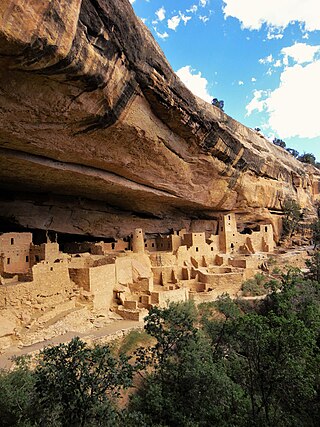Related Research Articles

The Brule Formation was deposited between 33 and 30 million years ago, roughly the Rupelian age (Oligocene). It occurs as a subunit of the White River Group in South Dakota, Nebraska, Colorado, North Dakota, and Wyoming.
The Gardener's Clay Formation is a Pleistocene geologic unit straddling the New York-New Jersey border. Fossil fish vertebrae and teeth are preserved in its sediments.
The Hannold Hill Formation is an Early Eocene (Wasatchian) geologic unit in the western United States. It preserves the fossilized remains of the ray Myliobatis and gar.

The Culpeper Basin is one of the Newark Supergroup's Triassic rift basins. It lies east of the Appalachian Mountains and extends from the Madison County—Orange County line in Virginia to Frederick, Maryland. A diverse group of sedimentary rocks including siltstone, sandstone, and conglomerate within the basin were intruded by igneous rocks, which caused thermal metamorphism at the contact with sedimentary rock.
The Pen Formation is a Campanian-age geologic unit in the western United States.
The Bell Canyon Formation is a geologic formation found in the Delaware Basin of southeastern New Mexico and western Texas. It contains fossils characteristic of the Guadalupian Age of the Permian Period.
The Doughnut Formation is an Upper Mississippian geologic unit in the western United States. Fish fossils have been discovered in shale outcrops of this formation in Dinosaur National Monument.
The Shedhorn Sandstone is a Permian geologic unit in the western United States. Fish fossils were first discovered by Harry Nazer in its rocks.
The Brushy Canyon Formation is a Permian geologic unit in Guadalupe Mountains National Park. The formation contains fan sandstones that were deposited under ancient seawater during the Middle Permian. These rocks contain abundant fish fossils like sharks' teeth preserved within small phosphatic nodules.
The Cabrillo Formation is a Maastrichtian stage geologic formation in coastal San Diego County, southern California. It is part of the Rosario Group. The Maastrichtian stage is of the Late Cretaceous Epoch, during the Mesozoic Era.
The Titus Canyon Formation is an Late Eocene-aged geologic formation in Inyo County, California. It was deposited in an inland freshwater environment, and preserves fossil fish and mammal specimens.
The Bull Run Formation is a Late Triassic (Norian) stratigraphic unit in the eastern United States. Fossil fish bones and scales have been found in outcrops of the formation's Groveton Member in Manassas National Battlefield Park. Indeterminate fossil ornithischian tracks have been reported from the formation.

The Cliff House Sandstone is a late Campanian stratigraphic unit comprising sandstones in the western United States.
The Glenns Ferry Formation is a Pliocene stratigraphic unit in the western United States. Outcrops of the formation in Hagerman Fossil Beds National Monument preserve the remains of seven fish species, five of which are extinct. These include the teleosteans Mylopharodon hagermanensis, Sigmopharyngodon idahoensis, and Ptychocheilus oregonensis, Ameirurus vespertinus, and the sunfish Archoplites taylori. A nearly complete skull of the catfish Ameirurus vespertinus was recovered in 2001 from the wall of the Smithsonian Horse Quarry.
The Lost Burro Formation is a Middle to Upper/Late Devonian geologic formation in the Mojave Desert of California in the Western United States.
The Fernando Formation is a Plio-Pleistocene marine mudstone, siltstone and sandstone formation in the greater Los Angeles Basin, Ventura Basin, and Santa Monica Mountains, in Los Angeles County of Southern California.
The Pico Formation is a Pliocene epoch stratigraphic unit and geologic formation in the greater Los Angeles Basin, the Santa Monica Mountains, and the Santa Susana Mountains, in Los Angeles County of Southern California.

Blieckaspis priscillae is a pteraspidid heterostracan agnathan from the Middle Devonian of North America.
Squatirhina is a genus of Late Cretaceous cartilaginous fish whose fossils have been found in the Aguja and Pen Formations of Big Bend National Park, Texas, USA.

Burrow fossils are the remains of burrows - holes or tunnels excavated into the ground or seafloor - by animals to create a space suitable for habitation, temporary refuge, or as a byproduct of locomotion preserved in the rock record. Because burrow fossils represent the preserved byproducts of behavior rather than physical remains, they are considered a kind of trace fossil. One common kind of burrow fossil is known as Skolithos, and the similar Trypanites, Ophiomorpha and Diplocraterion.
References
- 1 2 Google Books: United States Geological Survey Professional Paper - "Geology and ore deposits of Inyo County, California"
- ↑ "Death Valley National Park," Hunt, Santucci, and Kenworthy (2006); page 63.
- ↑ Hunt, ReBecca K., Vincent L. Santucci and Jason Kenworthy. 2006. "A preliminary inventory of fossil fish from National Park Service units." in S.G. Lucas, J.A. Spielmann, P.M. Hester, J.P. Kenworthy, and V.L. Santucci (ed.s), Fossils from Federal Lands. New Mexico Museum of Natural History and Science Bulletin 34, pp. 63–69.